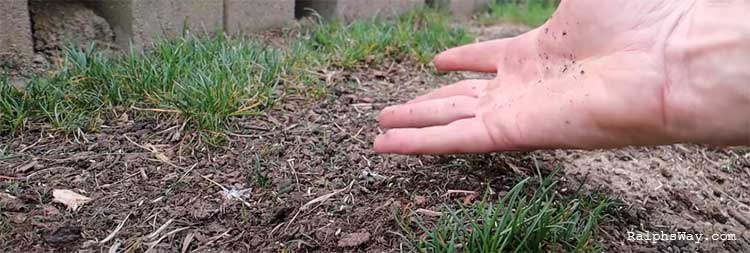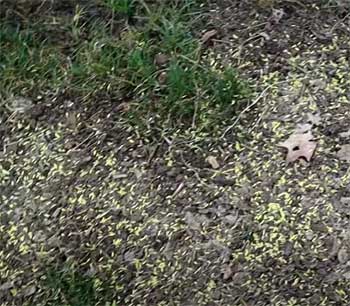Have you recently noticed bare spots in your newly seeded lawn? This single thing is enough to destroy the beauty of your land. So, it’s common to find out why it happens and how to get rid of it once and for all.
Put a smile on your face as I’ll disclose the most effective way to fix bare spots with luscious green seeds. For this, you’ll have to follow specific steps, which is what the post is about!
Reasons for Bare Spots in Newly Seeded Lawn

Bare spots don’t occur for a single cause. There might be a lot of possibilities behind the reason for bare spots. Some of them are listed below –
- Heavy foot traffic appears to be the most common reason you end up with bare spots, especially when natural foot traffic pounds a single area continuously.
- Path diseases, also known as turf diseases, tend to damage grass in round shapes.
- In case you over-fertilize a single spot of your lawn or mow your land excessively, it’s common to end up with bare spots!
- Pet urine is another common reason you get your newly seeded spots bare in one area particularly.
How To Fix Bare Spots On A Lawn?
Let’s cut to the chase! Although there are multiple ways to fix the bare spots of your lawn, all won’t appear to be user-friendly. So here, I’d like to share the must-try and most effective method you need to try to get rid of bare spots.
Reseeding Bare Spots Method
Believe it or not, patching the existing spots through seed is one of the most affordable and easiest techniques. And guess what? It won’t take more than 20-25 minutes to let you get a spot-free lawn!
So, without further ado, let’s get into the steps:

Things Required:
- Loamy soil or compost
- A garden rake
- Grass seed
- Hand cultivator
Step-1: Remove Residue/Debris
Eliminating and raking dead grass, debris, and such things are what you’ll do by taking assistance from a garden rake.
Alongside it, it’s better to make sure whether there is any “grub damage” area or not. If yes, then you must fix it individually.
Step 2: Break Up and Make Up the Soil
Let’s take help from a garden cultivator/lawn rake to loosen the soil. For the step, provide less pressure only to loosen the bare spots.
Once you’ve done it, ensure to spatter a few inches of loamy soil or compost. Then, mix it up carefully into the soil you picked up inside the rake. Don’t forget to keep your garden rake in an upside-down position.
To even the surface of your lawn as much as possible, I’d suggest using the top edge. There is nothing wrong if you spread topdressings into your surroundings. Now, you’re just a step away from wrapping up the task!
Step-3: Sprinkle Seeds Evenly
Here, spread the newly collected seeds as evenly as possible throughout the bare spots. They must be thick enough so that you can hide those spots in the smartest way possible. But they shouldn’t be too thicker, keep in mind.
Step-4: Water the Soil Gently
There is nothing alternative to watering the soil after every certain period. As we all can’t live without taking water, the same thing goes for plants. As a result, you must water the bare spots that you’ve filled with new seeds.
For this, I’d suggest watering the area after sprinkling seeds only if the weather appears too sunny. Otherwise, it’s okay to water the seed the next day when those grasses get well attached to the spots.
And note that everybody should gently and briefly water the seed 2-5x per week, depending on the temperature of your country.
Tip: Indeed, a couple of different grass seed products are available in the market. Some of them include paper material (recycled), absorbing moisture, and keeping the new seeds in place.
In contrast, others are mixed up with compost. Any of them can be your ultimate go-to. All you need is to confirm that you’re becoming able to fix those bare spots economically and effectively.
Frequently Asked Questions (FAQ)
Fixing bare spots on newly seeded grass require following a couple of steps. If grubs or such pests infect the area, it’s necessary to kill those pesky little things using fertilizers.
On the other side, if the reason behind bare spots is excess foot traffic, over-fertilizing, or pet urine, then I’ll fix the area following the above-written steps.
Improper watering is one of the main culprits behind a patchy lawn. If your land has filled up with new grasses or seeds, I’d recommend watering it twice a week. And remember that both overwatering and under-watering can result in a patchy lawn.
Yes, most new grasses tend to grow naturally and laterally to fill your lawn’s bare spots. Either get the Stolon or Rhizome grasses to achieve the best outcomes.
To fix bare spots, especially when they get almost dead, you need to remove the existing seeds and replace them with new grasses. It’s equally necessary to break up the old soil of that patchy area and add further to ensure better fertility. After adding new soil and seeds, make sure to water them gently.
Last Words!
Bare spots in the newly seeded lawn can dramatically ruin the whole aesthetic! So, to bring back the beauty of the land, it’s better and safe to fix it as soon as possible.
Among the multiple methods, I tried to teach you the simplest and most effective way to eliminate bare spots. It doesn’t matter whether the area gets ruined by pet urine, heavy foot traffic, or anything else; reseeding bare spots with new grasses always come in handy!
